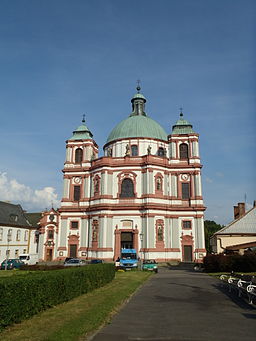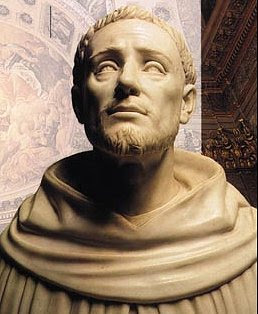Sunday, 1 June 1997. We were walking or standing around the red sarcophagus in the crypt of the Basilica of St. Lawrence and St. Zdislava in Jablonné v Podještědí, participants of an international Dominican meeting. I knew nothing about her, and I honestly wasn’t that interested in learning more either - the pilgrimage was just part of the programme to celebrate her feast day. Thus I was taken completely by surprise as the floodgates of my eyes suddenly burst open, like it happened to the haughty Fra Lazzarino when Saint Catherine of Siena prayed for him. Coming up and out into the sun, I learnt that two of my companions had experienced the same sudden flood of tears, some years before. Ah, you too...
Sunday, 6 February 1228. Prague Castle woke up to a great celebration. Old king Přemysl Otakar had seen fit to arrange the coronations of his son Václav and wife Kunigunde while he was still around to secure his succession. Among the nobles witnessing the solemnity in St. Vitus Cathedral must have been Lady Sibyla, who had come to the Czech lands as lady-in-waiting of Kunigunde of Schwaben, and Sibyla’s oldest daughter, 8 year old Zdislava.
We can imagine the joy and curiosity of the little girl - a bright child, a lively child, a fearless child... Zdislava, remembered to this day in Křižanov for chasing away a bear that threatened another girl in “her” forest, the forest where the pious little girl thought she might become an anchoress! Well, she didn’t.
St. Zdislava would come to marry Havel, Lord of Lemberk. In the forests of Northern Bohemia, 80 km from Prague as the crow flies, they raised four children that we know of - Havel, Markéta, Jaroslav and Zdislav.
Born into a family who spent all their resources on the building of castles, convents and churches - indeed her father, Burggrave Přibyslav of Křižanov, was described as “knight on the outside, monk on the inside” - it seems only a matter of course that St. Zdislava would do the same.
Queen Kunigunde was a great promoter of the Friars Preachers (and the nuns) in her lands, and it may well be that it was her enthusiasm that inspired Sibyla and her daughters to join the supporters. They would have met friars in Brno and Prague, some of St. Dominic’s first disciples very likely among them - preachers like St. Hyacinth, Bl. Czeslaw, Bl. Sadoc, Paul of Hungary... St. Zdislava had much in common with St. Dominic, perhaps that resonated with her? Raised in a castle by pious Christian parents, she received a good education, did what was expected of her - and then some!
St. Zdislava became a Dominican penitent woman, striving for Christian perfection according to her state in life - which in her case meant embracing a life of responsibilities, work and action. Raised from childhood to take charge as châtelaine, her husband away for weeks or months at a time, the Lady of Lemberk certainly had work cut out for her.
With her husband, she founded a Dominican convent in Jablonné v Podještědí, the town below the castle and then another one in Turnov. She set up a hospital in Jablonné, with herself as doctor and nurse, performing many miracles. Restoring sight to the blind, raising five people from the dead, curing a priest of madness! You can still find the Wellspring of St. Zdislava under the hill, below the castle, the water known to be good for eyes, people filling their bottles and children running around.
In 1241, the mighty Mongol army launched an invasion of Europe. The Tartars attacked from the East and devastated Moravia, her homeland: killing, raping, maiming, burning, driving people to flee for their lives. The invasion was finally halted by Our Lady at Hostýn before reaching Bohemia, but until they retreated at the end of the year, many refugees came to Lemberk for shelter and food.
Living the faith, incarnating the faith; warmly burning her candle from both ends, devoted to her family, to the poor, to her country, to the Church, she died young - about 33 years old (of course) on 1 January 1252. Appearing later to her devastated husband Havel in a vision, she comforted him and left her red cape to him as witness of her presence and prayers - her devotion glowing even beyond death.
After time had stubbornly refused to erase her name from the scrolls of history, this good matron (a rare and precious epithet in the Dominican litany of saints) was beatified in 1907 by St. Pius X when Bl. Hyacinthe-Marie Cormier O.P. was Master of the Order. St. Zdislava was canonized in 1995 by Bl. John Paul II. Her memorial was initially set to 28 November in the Roman calendar, but later moved to 1 January. In the Dominican calendar she is remembered either 3 or 4 January, and in the Czech calendar she is celebrated 30 May with pilgrimages to the Basilica of St. Lawrence and St. Zdislava in Jablonné v Podještědí.
St. Zdislava, first lady of Dominican families, pray for us!
1. Pope Paul VI wrote in Evangelii Nuntiandi that “Modern man listens more willingly to witnesses than to teachers, and if he does listen to teachers, it is because they are witnesses.” To be a Doctor of the Church, one must first be a Servant of God, a Blessed, a Saint. St. Zdislava speaks more eloquently with her life than the most energetic preacher does with words, if that preacher is not a saint too. Do we keep in mind that our preaching is supposed to be grounded in prayer, to proceed from an abundance of contemplation in a life striving for Christian perfection?
2. From the life of St. Zdislava, we get a glimpse of how the Order came to spread all over Europe in a few years - through the eager and faithful support of “fading gentlewomen” and their families. These “Dominican families” often preceded the establishment of convents and monasteries, supported them with everything when they were there, and remained long after they were gone - in the 20th Century as well as the 13th. What is the relationship between secular and religious Dominicans in our region?
3. For every “preaching ace” on a chair of learning or pulpit, there might be “36 humble ones” in the ground crew for the show to go on. We love and need our “aces”, but do we tend to the ground crew as well - are we ourselves willing to be ground crew for our brothers and sisters?









